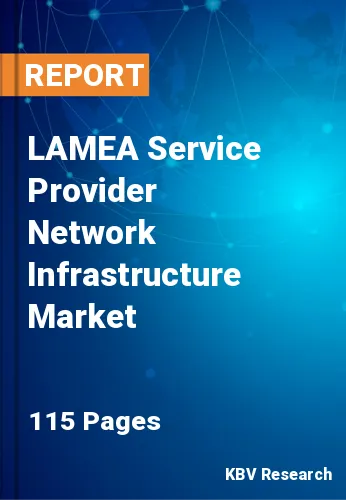
The Latin America, Middle East and Africa Service Provider Network Infrastructure Market would witness market growth of 7.3% CAGR during the forecast period (2022-2028).
Customers and companies are used to the concept that they should be able to access the Internet from any location, whether they are at home or are seated at a nearby coffee shop. Companies must make costly infrastructure investments, such as fiber optic cables, to provide high-speed connectivity. Tier 1 ISPs frequently give the impression of being the only provider in their areas due to the increasing price of investment. Consequently, a certain business may seem to have near-total control over the market in a particular sector.
An ISP can buy wholesale bandwidth from a network service provider (NSP), which connects its clients. Customers then connect to the network via the ISP's last-mile equipment, which connects to the backbone of the NSP. From there, the NSP directs all traffic and offers the network connectivity infrastructure. To fulfill traffic demands, the NSP constructs maintains and grows its infrastructure. ISPs are in charge of their networks, sales, marketing, and customer care. It can also buy other services from NSPs, such as cloud-based services or Web hosting, and resell them to end customers under their brand name. This is known as white labeling.
The expansion of big data & analytics, increasing government initiatives, increased ICT spending, and technological advancement in various countries are all factors in this growth. For instance, the governments of the Gulf Cooperation Council (GCC) nations are focusing on innovative national development initiatives like the Vision 2030 and 2021 plans of Saudi Arabia and the United Arab Emirates. Through the expansion of IT infrastructure, these projects help to improve cloud-based services and diversify the economy. The UAE's competitive standing in numerous competitiveness surveys is displayed in the UAE Digital Transformation Report 2020 by the Telecommunications and Digital Government Regulatory Authority. It describes the UAE's triumphs in the digital transformation and how they affected customer satisfaction and the quality of government services.
To exist, sustain, and develop, the digital practice needs to make use of every component. This includes meetings, which are more crucial than ever in the era of digital conferencing, as well as e-commerce, networking sites, SEO, data analytics, corporate transportation, planning, and application services.
The Brazil market dominated the LAMEA Service Provider Network Infrastructure Market by Country in 2021, and would continue to be a dominant market till 2028; thereby, achieving a market value of $3,145.3 million by 2028. The Argentina market is anticipated to grow at a CAGR of 7.9% during (2022 - 2028). Additionally, The UAE market would showcase a CAGR of 7% during (2022 - 2028).
Based on Enterprise Size, the market is segmented into Large Enterprises and Small & Medium Enterprises. Based on Industry, the market is segmented into BFSI, Government & Defense, Manufacturing, Telecom & IT, Retail & Ecommerce, and Healthcare & Life Sciences. Based on Technology, the market is segmented into Broadband Access & Optical Transport, Routers & Switches, Carrier IP Telephony, Microwave transmission & Mobile Backhaul, and Wireless Packet Core. Based on countries, the market is segmented into Brazil, Argentina, UAE, Saudi Arabia, South Africa, Nigeria, and Rest of LAMEA.
Free Valuable Insights: The Global Service Provider Network Infrastructure Market is Predict to reach $174.1 Billion by 2028, at a CAGR of 4.5%
The market research report covers the analysis of key stake holders of the market. Key companies profiled in the report include Huawei Technologies Co., Ltd., Juniper Networks, Inc., Broadcom, Inc., Alcatel-Lucent Enterprise, Avaya Inc., ZTE Corporation, Ericsson AB, Aruba Networks (Hewlett Packard Enterprise Company), and Nokia Corporation.
By Enterprise Size
By Industry
By Technology
By Country
Our team of dedicated experts can provide you with attractive expansion opportunities for your business.
